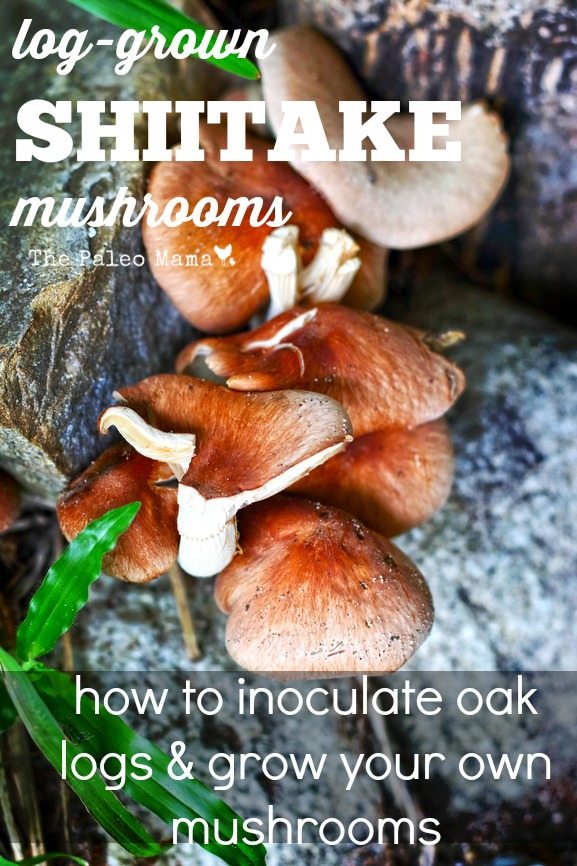
Moving onto a beautiful, fully-functioning farm like Frank and I just did is a bit like having your first child; it needs your love and care immediately—even if it didn’t come with a Farming for Dummies instructional manual. That’s what happened when we went for a walk on our land; we found oak logs already inoculated with lots of potentially tasty Shiitake mushrooms, and not much “this is how to take care of them” from the former owners on how to take care of these log-grown shiitake mushrooms.
So, as with many other farming chores, we began our own research into raising Shiitake mushrooms successfully. I want to share some of the basic information we have uncovered that should allow us—and you, if you would like to join us by growing your own—to harvest some delicious and healthy log-grown Shiitake mushrooms.
In this blog post I will provide some basic, practical answers to these five important questions:
- Why grow Shiitake mushrooms?
- How do I prepare my logs for growing Shiitakes?
- What do I do with my inoculated logs?
- Why do I have to shock my inoculated logs before harvest?
- When can I harvest my Shiitakes?
By following the information in these answers, we will be able to reap a bountiful harvest of these delicious and healthy Shiitake mushrooms.
1. Why grow Shiitake mushrooms?
Are you thinking, “Why on earth would I want to grow fungi?” If you’ve never learned to appreciate the taste of the many different kinds of edible mushrooms, that’s the place for you to start! Get beyond your knowledge that mushrooms are fungi, and get some sample tastes of how delicious and healthy these mushrooms are. Shiitake mushrooms are the third most popular mushroom in the world, and they are perphaps the healthiest of them all! Here are four unbelievable benefits to Shiitakes:
- They are loaded with B-Complex vitamins.
- They are believed to deliver anti-cancer properties to your body when you eat them.
- They are low in calories, yet high in fiber content and loaded with protein.
- They contain a multitude of minerals. Just one raw serving contains 1/20 of the magnesium and potassium you need each day, along with 10 percent of the phosphorus. But eat them dried or raw because they lose up to ¾ of their nutritional value.
2. How do I prepare my logs for growing Shiitakes?
The name shiitake mean “mushroom of the oak,” but shiitake mushrooms will also grow on sugar maple, hophornbeam, ironweed, alder, poplars, and yellow birch. But the mycelium’s (the vegetative part of a fungus, consisting of a network of fine white filaments) favorite food for producing a flush of lovely brown shiitake caps is oak, either white or red.
It’s not necessary to cut down an oak tree in order to get the logs you need for your mushroom growing. You can read some expert tips for acquiring logs from unique sources here (page 10). However you cannot grow shiitake on dead wood, such as old logs in your yard or woodland, or on firewood, because local fungi have contaminated these logs or the logs have dried out.
Early spring, before the trees leaf out, is the season most suggested for inoculating bolts for mushroom production. The logs should be 4-6 inches in diameter, which gives a prime amount of sapwood (the lighter colored outer layer), which is the primary part of the log where the fungi will colonize.
You will need to have a supply of shiitake mushroom spawn (mushroom mycelium) which is already impregnated in wooden dowel plugs, either in liquid form or mixed with sawdust. If you are using impregnated wooden plugs, use a 3/8-inch drill bit to drill to a depth of 1-1/4 inches before pressing in the plugs. Drill in 10-inch intervals down the length of the log. Leave 2 inches between each row, and stagger the holes from one row to the next. Then you will need to cover each plugged hole with very hot food grade wax (cheese wax or even beeswax will work) to ensure an airtight, flexible seal. CLICK HERE to order mushroom spawn.
3. What do I do with my inoculated logs?
Now you are ready to create your laying yard—the place where the inoculated logs will incubate, and where you can give routine maintenance to them. This should be in a place of year-round shade to keep the logs from drying out due to sun and wind. A laying yard under the canopy of a forest is best. If you have just a small number of logs and no wooded area, behind the north side of a house or shed, along with a shade cloth, can provide year-round shade. Remember that you need to be relatively close to both electricity (for drilling), and water (necessary to irrigate and soak the logs).

There are several ways you can lay out your logs. A stack of criss-crossed logs works well, as well as forming an X-pattern by stacking logs end to end, leaning each log against a strong wire. Be sure to label each log with the date of inoculation, spawn type, and force date (see below). Keep the logs off the ground, stacking them on pallets or non-inoculated logs.
Your logs need an incubation period of 8 to 18 months, or spawn run, during which the fungus colonize the wood. You will need to maintain favorable conditions so the mycelium can spread through the logs as quickly and evenly as possible. Your maintenance will include:
- Keeping the moisture content well above 30 percent.
- Using artificial shading if the natural canopy of trees thins out.
- Protect the logs against competing fungi.
There are at least five common fungi competitors you may encounter: Black Bulgur or Bachelor’s Buttons, Trichoderma, Hypoxlyon, Turkey Tail, Split Gill fungus. You can find further information about fungi competitors here (pages 28-29).
4. Why do I have to shock my inoculated logs before harvest?
Shocking your logs, or forcing bolts, is a matter of speeding up Mother Nature. Shiitake mushrooms are one of the few mushrooms that can be made to fruit on demand. Shocking involves soaking logs in cold water for an extended period of time (12-24 hours) to induce fruiting. By shocking your logs on a schedule, you can generate a steady supply of shiitake mushrooms on a predictable rotation.
There are several ways to determine if your logs are ready for shocking. One option is to observe the mycelium growth (white discoloration) on the end of the bolt. During March-April, and October-November, logs are allowed to fruit naturally with being soaked. During the warmer months, May-August, groups of logs are forced by shocking them every seven weeks. You will find complete information for these shocking procedures here (pages 30-34). We shocked our logs this week by putting all 20 of them in the creek that runs through our property. You can, also, use a child’s swimming pool or a livestock trough.
5. When can I harvest my Shiitakes?
Shiitake mushrooms are usually ready to be harvested 7-10 days after shocking. Gills should be visible, and the outer edge of the mushroom should be slightly curled under. It’s normal to expect ¼ to ½ pound of mushrooms per log, or a higher yield with two shockings per season. Over the course of five years, each log should produce 3-4 pounds of fresh mushrooms.
When harvesting mushrooms, the goal is to efficiently remove the mushrooms without damaging the bark. Most experiences growers simply twist and pull the mushrooms off the log using their hands. Gently brush off any dirt and place each mushroom in an open basket or paper sack or other vented container. If you see thrips (tiny, slender black insects crowing in the gills) on your mushroom, they will usually dislodge by tapping lightly on the top of the cap.
For high-quality mushrooms, it’s important to get the in the refrigerator as quickly as possible, certainly within one hour of harvesting. Do not seal them in an airtight container. If you want to freeze your mushrooms, you must steam them first with a mixture of 1 teaspoon lemon juice or 1/5 teaspoons of citric acid per pint of water for 5 minutes to reduce darkening. Steam whole mushrooms for 5 minutes, pieces for 3.5 minutes. Cool promptly, drain and package, leaving ½ inch headroom.
You can also dry shiitakes, which will preserve them for up to a year. You will find great information on storing and preserving mushrooms here (pages 43-44).
Now all that is left…
…is enjoying these wonderfully tasty and healthy shiitake mushrooms. While you are waiting to harvest your Shiitake mushrooms, start collecting some delicious recipes for ways to add them to your diet. One of the first things I want to make when we harvest our first crop of Shiitake mushrooms is some delicious Shiitake Soup!

Sources:
- https://www.healthy-holistic-living.com/mushroom-information.html
- https://www.treehugger.com/green-food/how-to-grow-shiitake-mushrooms.html
- https://northernwoodlands.org/articles/article/growing_shiitake_mushrooms
- https://www.uvm.edu/~susagctr/resources/ShiitakeGuide.pdf
- https://www2.ca.uky.edu/agc/pubs/for/for81/for81.pdf
- https://www.centerforagroforestry.org/pubs/mushguide.pdf
It’s actually a great and useful piece of information. I’m happy that you just
shared this useful information with us. Please keep us up to date like this.
Thanks for sharing.
This web site certainly has all the information and facts I
wanted about this subject and didn’t know who to ask.
Pretty! This was a really wonderful article. Thanks for providing this
information.
Do you mind if I quote a couple of your posts as long as I provide credit and sources back to your
site? My website is in the exact same area of interest
as yours and my visitors would truly benefit from a lot of
the information you present here. Please let me know if this okay with you.
Many thanks!
It’s fine to quote from my post as long as you are sourcing it back to my website each time.
Greetings I am so excited I found your webpage, I really found you by mistake, while I was researching on Aol for something else, Anyhow I am here now
and would just like to say thank you for a marvelous post
and a all round enjoyable blog (I also love the theme/design), I don’t have time to go through it all at the moment but I have saved it and also included your RSS feeds, so when I have time I will be
back to read a lot more, Please do keep up the awesome jo.